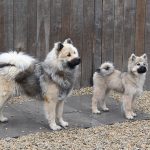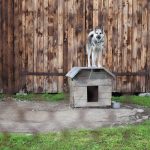- Home
- /
- Blog posts
- /
- Appropriate Diets for Dogs
There are multiple different choices of diets to choose from when it comes to feeding your dog. It is important to keep in mind that all dogs are different and what may be an appropriate diet for one, may not be an appropriate diet for another. Domesticated dogs are typically carnivores that can eat some omnivorous foods where appropriate. Some of the diets that will be covered here are:
- Kibble/dry food
- Wet tinned food
- Vegetarian
- Raw
- Dietary requirements
If you are struggling to decide what diet is suitable for your dog, you can contact a vet who will be able to advise you accordingly, also see our article on foods you shouldn’t give your dog.
What to expect from our article
What Should I Feed My Dog?
Their food needs to be complete and balanced to ensure that they are receiving all of the good things from food that they need to be healthy. When choosing a brand of dog food, always check the label to make sure that it is labelled as ‘complete’. This means that it contains all of the essential and recommended nutrients that your dog will need.
You should also make sure that the food that you are purchasing is suitable for your dog’s stage in life. There are three categories to choose from which are; puppy, adult, and senior. If your dog has any other requirements for food, make sure that it is suitable for their additional needs. Some factors that may affect their diet are weight, breed, size, and pregnancy.
There are wet, dry, and raw diets available that you can choose from. You may also have to alter your dog’s diet if they have any dietary requirements or allergies that affect what they can and can’t eat.
Wet Food for Dogs
Wet food is typically the most common option for dog food and lots of dogs prefer to eat wet food over dry. It is more expensive than dry food and can go off quickly. Make sure that any wet food is not left out for long periods of time, especially in warmer weather. Any food that is leftover after two hours should be disposed of.
There are lots of different flavours and textures available and it is completely up to you to choose which one to feed your dog. However, it is worth noting that some dogs may dislike certain flavours or textures of food. If this is the case, then you may need to switch to a different type that they may prefer.
Some benefits of wet food are that it’s more easily digested, most dogs like it, and its high moisture content can help to keep your dog hydrated. This food tends to be tastier to dogs because it is made primarily of protein and fat. It can be a good choice for picky eaters, and even dogs with certain health conditions. A negative of feeding your dog wet food is that its soft and smooth texture doesn’t give your dog the crunchy texture that can help to clean their teeth
Wet food from a tin is easy and simple to prepare and there also aren’t any preservatives, yet it still has a long shelf life. This type of food is typically low-carb, but you can often find meat bi-products in cheaper dog food, so make sure to read up on what the food actually contains.
Dry Food For Dogs
Another option for food for your dog is dry food, or ‘kibble’. Dry dog food is typically cheaper than wet dog food, so if you’re on a budget, this may be a better option for you as it can be more cost effective. Commercial dry food also includes a guarantee of nutritional ‘completeness’, which means that it will provide all the essential nutrients that your dog needs.
However, dry food does often include some low quality ingredients such as meat bi-products, sweeteners, and preservatives. Whilst the preservatives help to keep the food fresher for longer, they can contain unhealthy chemicals. Dry dog foods are also typically higher in carbs and the quality of ingredients varies in different products. Another thing to note, is that the closer that this type of food gets to its expiry date, the less vitamins that will be present as they diminish in quality over time.
Can I Mix Wet Dog Food and Dry Dog Food Together?
There are different factors that can mean that you may have to feed your dog solely wet or dry food. However, there may also be times when mixing both types of food can be beneficial. This method is called ‘topping’ This can be especially helpful for dogs with certain food aversions.
Raw Food for Dogs
Many companies have now expanded into producing raw food diets for pets and raw food now comes readily available in most popular pet shops. This food can come either freeze dried or frozen. It is important to know that you should fully defrost any raw meat that you are giving to your dog before serving. If you are thinking about feeding your dog a raw diet, vets usually recommend feeding them a commercially prepared diet to ensure that they are getting the correct nutrients that they need. This can be hard to monitor in a raw diet, but not impossible.
What is Raw Feeding?
Raw feeding is when you feed your dog raw ingredients Instead of the cooked food that is readily available to purchase. A raw diet is made up of a variety of raw meats and sometimes other raw ingredients such as specific fruits and vegetables.
Benefits and Negatives of Raw Feeding
People usually feed their dog a raw diet because it is seen as a more natural option. Some of the foods that are typically used for a raw diet are fruit, vegetables, raw eggs, raw meat, muscle meat, and organ meat.
Some of the potential benefits of raw feeding can include:
- Shiner coats
- Healthier skin
- Cleaner teeth
- Higher energy levels
- Smaller stools
However, there are also risks associated with a raw diet such as:
- A threat to health through the bacteria in raw meat
- An unbalanced diet that can be damaging
- Potential for choking on bones
Vegetarian Diets for Dogs
If you are a vegetarian or a vegan, then you may wish to feed your dog a vegetarian diet. Dogs can eat both meat and plant-based foods, but it is important to check with your vet to make sure that it is a suitable and healthy diet for your dog. Some dogs may have dietary requirements that make them unable to sustain a vegetarian diet.
If you are buying commercially available food that is appropriate for your dog’s age, then it is possible for them to still get all of the nutrients that they need. With homemade meals, it is harder to make sure that your dog is getting everything that they need out of their diet.
Food Allergies and Dietary Requirements
Allergies and intolerances are two separate issues that your dog can face. An allergy involves the immune system and is often triggered by a response to protein. A food intolerance is an abnormal response to the food that does not involve the immune system. However, the symptoms of both of these issues can often be similar and can include:
- Vomiting and diarrhea
- Itchy skin and hives
- Poor skin and coat
- Chronic ear or foot infections
- Red, inflamed skin
- Swollen face, ears, lips, or eyelids
- Sneezing
- Runny eyes
- Constant licking
If your dog is displaying any of these symptoms, you should contact a vet as soon as possible. They will be able to conduct allergy testing, or find out what is causing the problem through the process of elimination. Eliminating certain aspects of food from your dog’s diet can help to expose the issue.The best way to treat a food allergy or intolerance is to try to avoid the food that is causing the problem. Your vet will be able to recommend a suitable diet for your dog to follow.
How much Food Should I Feed My Dog?
The amount of food that your dog needs will depend on their size, breed, and age. You should never over-feed or under-feed your dog, so if you are unsure, speak to a professional. There will usually be a feeding guide on the label of the food you have purchased that will show you how much you should be feeding to a dog of a specific size. Unless stated otherwise, this is the amount of food that you should be feeding your dog over a 24 hour time period. You may need to split this amount up into separate meals for your dog if they require it.
How Much Food Do Puppies Need to Eat?
Puppies grow a lot faster than adult dogs, so they typically need feeding more often to accommodate for this. Puppy nutrition is really important for developing a foundation for future growth and for bone and organ development. Puppies usually require smaller amounts of food, but more frequently. This will gradually change as they grow older.











Trackbacks/Pingbacks